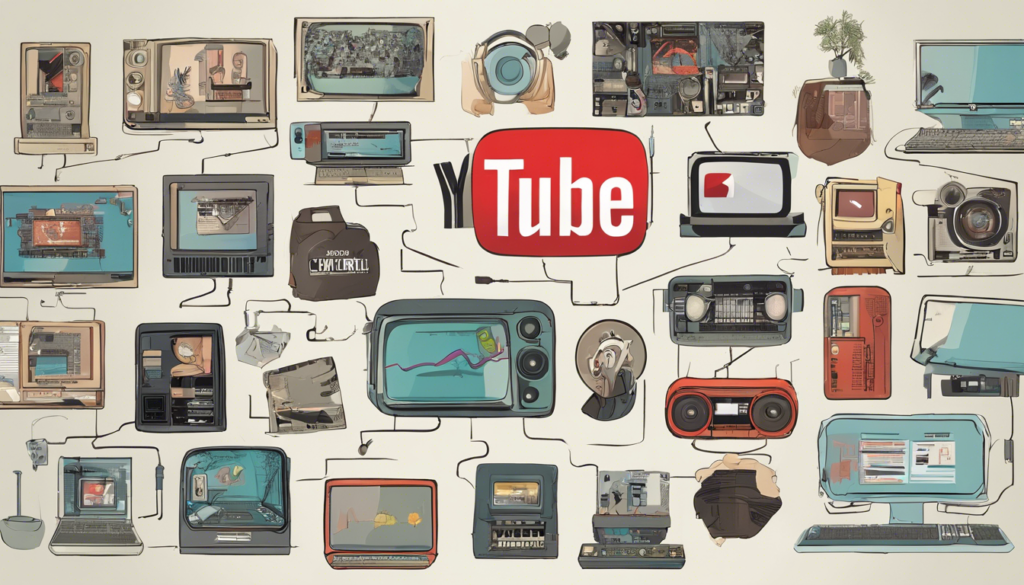Have you ever wondered when was YouTube created and how it became the video-sharing juggernaut it is today? YouTube, now owned by Google, has come a long way since its inception in 2005. What started as a simple platform for user-generated content has evolved into a global entertainment hub, reshaping the way we consume and share videos.
This article delves into the fascinating history of YouTube, tracing its humble beginnings, key milestones, and the innovative features that propelled it to unprecedented success. We’ll explore the birth of YouTube, its early struggles, and the game-changing moments that transformed it into a cultural phenomenon. Additionally, we’ll examine YouTube’s business model, ad revenue streams, and the impact of Google’s acquisition on the platform’s growth.
The Birth of YouTube
YouTube’s origins can be traced back to February 14, 2005, when three former PayPal employees – Chad Hurley, Steve Chen, and Jawed Karim – founded the platform as an online video-sharing service. Their vision was to create a simple interface that would allow users to easily publish, upload, and view streaming videos through standard web browsers and modern internet speeds.
Original Use Case
The initial concept behind YouTube was an online dating service called “Tune In, Hook Up.” However, after the infamous Janet Jackson and Justin Timberlake incident at the 2004 Super Bowl halftime show, the founders realized the lack of a platform to share such viral videos online. Recognizing the potential, they pivoted their idea to become the first major video-sharing platform.
Founders and Initial Development
The three founders brought complementary skills to the table. Hurley, with his design background from Indiana University of Pennsylvania, crafted the logo and website’s visual appeal. Chen, a computer science graduate from the University of Illinois at Urbana-Champaign, ensured the platform’s technical functionality. Karim, also a computer science graduate from the same university, assisted in programming and design.
Initially operating from an office above a pizzeria and Japanese restaurant in San Mateo, California, the team launched YouTube on April 23, 2005, with the first video titled “Me at the zoo” uploaded by Karim. This humble beginning marked the start of a revolution in user-generated content and video sharing.
Key Milestones in YouTube’s Growth
From a basic video-sharing network, the Alphabet summary has developed into a large corporation with many verticals; Google does not provide financial data regarding YouTube, but estimates in April 2013 indicated sales figures at about $5 billion. Let’s take a look at some key milestones in this video sharing platform’s growth:
Pre-Google Growth
YouTube experienced rapid growth in its early days. By March 2006, just months after its launch, the platform had over 25 million uploaded videos and was generating around 20,000 new uploads daily. During the summer of 2006, YouTube became one of the fastest-growing sites on the World Wide Web, hosting more than 65,000 new video uploads and delivering an average of 100 million video views per day in July.
Google Acquisition
On October 9, 2006, Google announced its acquisition of YouTube for $1.65 billion in stock. This acquisition kickstarted YouTube’s rise to becoming a global media dominator, creating a multi-billion-dollar business that surpassed most television stations and other media markets, sparking success for many YouTubers. By 2018, YouTube generated more than twice the revenue of any major TV network.
First Viral Videos
Viral videos played a crucial role in YouTube’s early growth after the Google acquisition. Videos like “Evolution of Dance,” “Charlie Bit My Finger,” “David After the Dentist,” and others became viral sensations, attracting millions of views and contributing to YouTube’s rapid expansion.
Now consuming as much bandwidth as the whole internet did in 2000, YouTube started its first “Paid Partner” program with early users of the site in May – attracting, to take one example, the family behind “Charlie bit my finger” almost $150,000.
It first left the US in June 2007 and started offering its services in nine different nations. When the platform teamed up with CNN to hold the debates for the 2008 US Presidential election a month later, it moved still another step toward mainstream appeal. The first ads on YouTube videos in August that same year addressed the long-asked subject of Google’s intended site monetisation strategy.
With more than 1.3 billion views on YouTube, the video of Korean pop musician “Gangnam Style” became #1 most-watched clip (behind only “Despacito” with over 6.8 billion views as of June 2020). With so many views, “Gangnam Style” “broke” YouTube. The view counter was changed to a 64-bit integer since it could not record values bigger than a 32-bit integer. For other reasons as well, that year was significant for the video-sharing site since it evolved into the preferred venue for August 2012 presidential election coverage.
Legal Troubles
Watching TV shows, music videos, and sports highlights on the platform was becoming rather common in 2007. Viacom, the proprietor of MTV and Nickelodeon, consequently presented a $1 billion copyright infringement case on the platform. Although the case was fixed to YouTube’s merit in 2010, the matter was finally settled by the two firms in 2014. English football’s Premier League’s protest of a similar nature shortly followed.
YouTube’s Business Model
YouTube’s primary revenue stream is advertising, enabling businesses to reach relevant audiences and grow their brands. Creators who are part of the YouTube Partner Program (YPP) are eligible to share in advertising revenue.
Ad-based Revenue
YouTube’s ad-based revenue model revolves around the TrueView ad program, which includes in-stream and video discovery ads. In-stream ads allow viewers to skip after the first five seconds, and advertisers pay only if the viewer watches for over 30 seconds or interacts with the ad. Video discovery ads are listed alongside regular content, and advertisers pay when viewers click on them. Additionally, Google Preferred allows advertisers to place ads on high-performing videos across various categories.
Subscription Services
YouTube Premium is a paid subscription service that offers an ad-free experience, offline viewing, and background playback. Revenue from YouTube Premium memberships is distributed to creators based on how much of their content members watch. YouTube Music Premium is a separate subscription service focused on ad-free music streaming, offline listening, and background playback.
Collaborations and Partnerships
YouTube has developed tools like Super Chat, channel memberships, and merchandise to help eligible creators earn additional revenue beyond advertising. These tools enable deeper connections with fans and alternative income streams, with revenue shared between creators and YouTube. Moreover, YouTube facilitates brand collaborations, allowing creators to integrate products seamlessly into their content while aligning with their values and audience.
Major Features and Updates Over the Years
Over the years, YouTube has introduced several major features and updates to enhance the user experience and cater to diverse audiences. Here are some notable ones:
YouTube Studio
YouTube Studio is a powerful platform that simplifies channel management. It serves as a one-stop-shop for uploading, editing, scheduling, and organizing your videos. You can access detailed analytics, engage with your community, customize your channel’s branding, and track your earnings seamlessly within YouTube Studio.
YouTube Premium
YouTube Premium, formerly known as YouTube Red, is a subscription service that offers an ad-free viewing experience across YouTube. Subscribers can save videos for offline viewing, play content in the background, and access exclusive original content created by popular YouTubers. Additionally, it provides ad-free music streaming through YouTube Music.
YouTube Kids
YouTube Kids is a dedicated app designed to provide a safe and curated environment for children. It offers age-appropriate content, parental controls, and a user-friendly interface. Parents can restrict access to certain videos, set screen time limits, and ensure their kids explore educational and entertaining content tailored for their age group.
YouTube Shorts
Introduced in 2020, YouTube Shorts is a short-form video experience that allows creators to share bite-sized, vertical videos up to 60 seconds long. Inspired by the popularity of platforms like TikTok, Shorts aims to capture the attention of a younger audience and encourage creative, snackable content.
Conclusion
YouTube’s journey from a simple video-sharing platform to a global media powerhouse has been remarkable. From its humble beginnings as an idea among three former PayPal employees to its acquisition by Google and subsequent rapid growth, YouTube has redefined how we consume and share video content. Its innovative features, user-friendly interface, and ability to foster thriving creator communities have solidified its position as a cultural phenomenon.
Looking ahead, YouTube’s future appears promising as it continues to adapt and evolve with emerging trends and technologies. The platform’s commitment to enhancing the viewer experience, providing opportunities for creators, and exploring new revenue streams ensures its relevance in the ever-changing digital landscape. As video consumption patterns shift, YouTube’s ability to stay ahead of the curve and embrace innovation will be crucial in maintaining its dominant position in the world of online video sharing.






